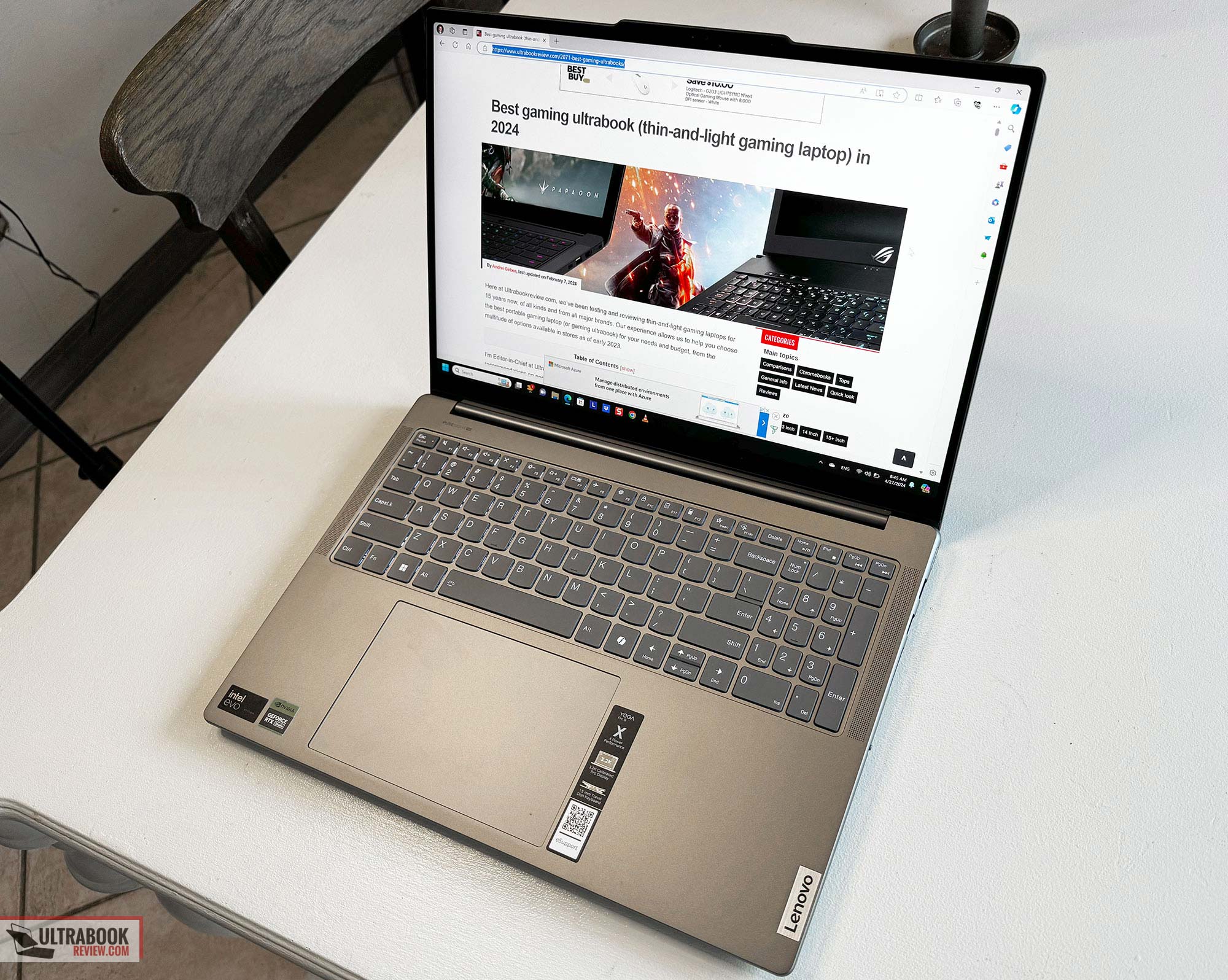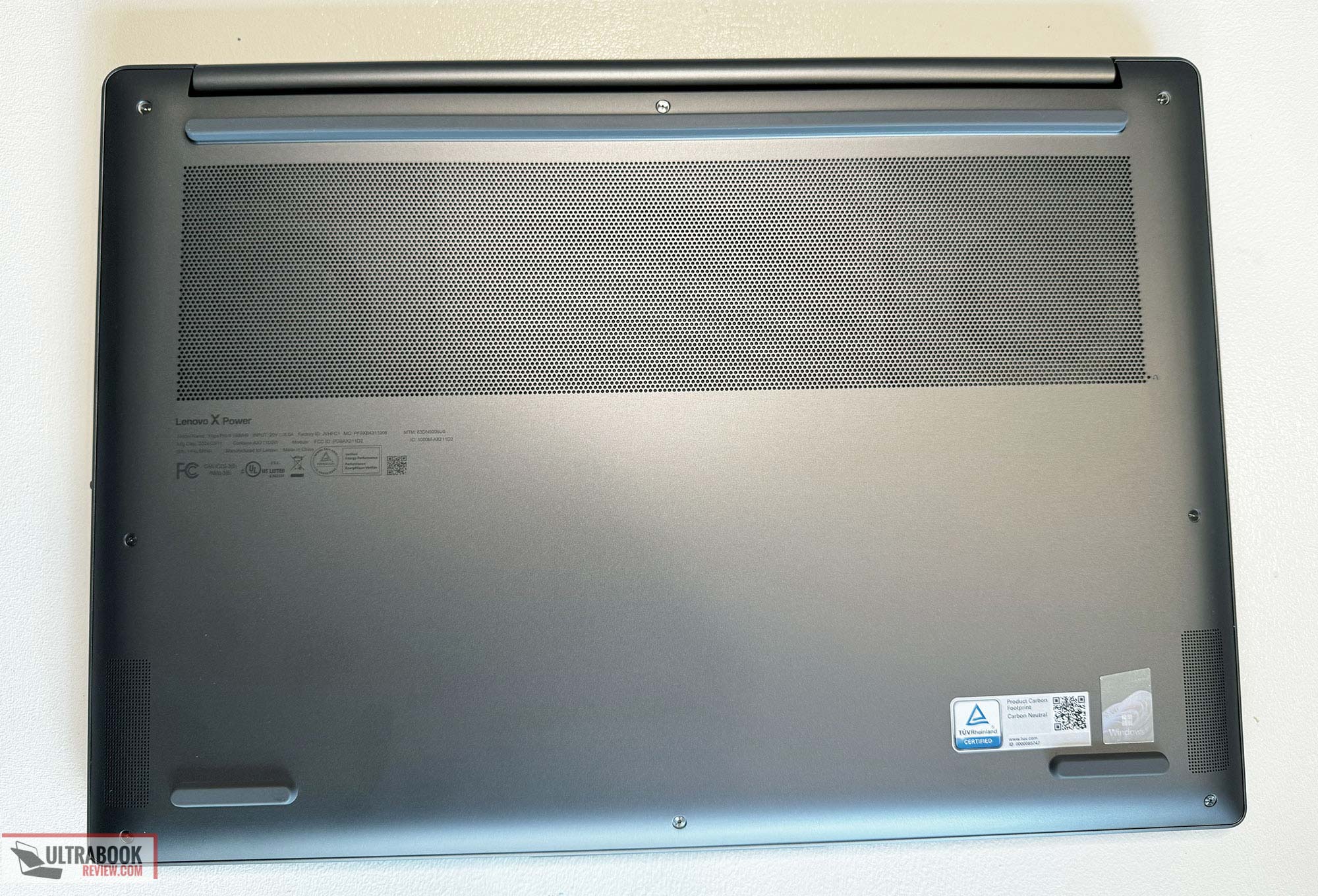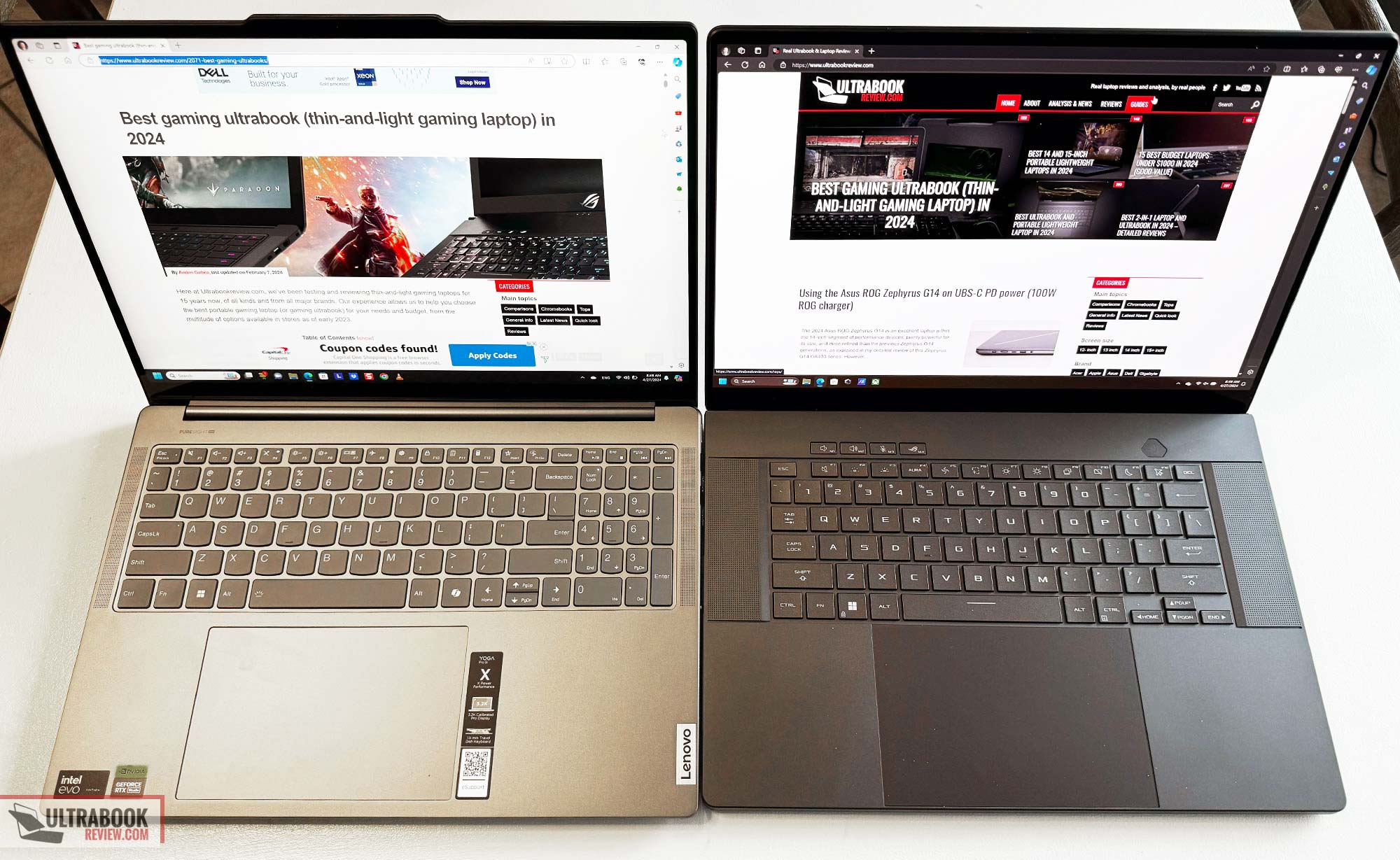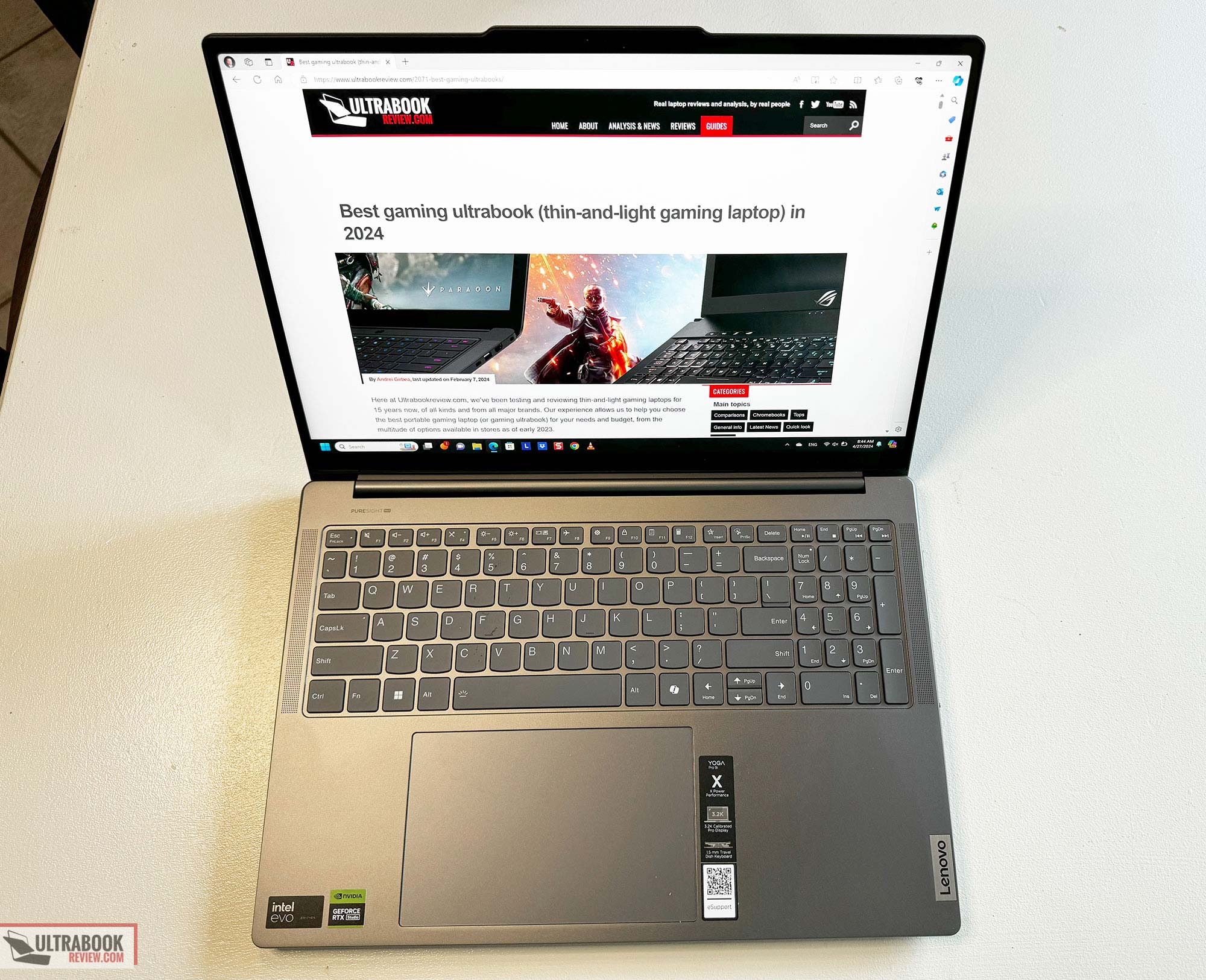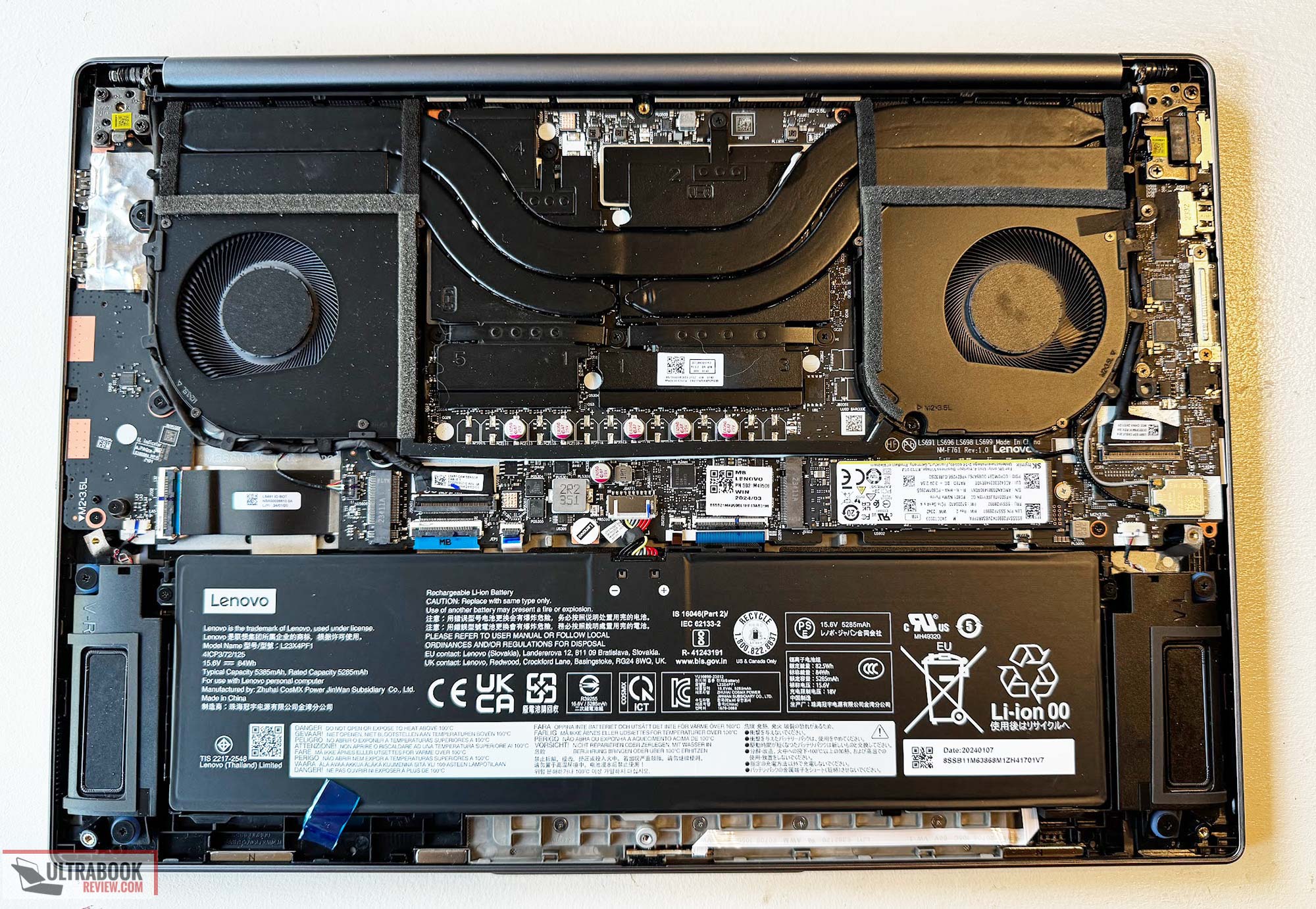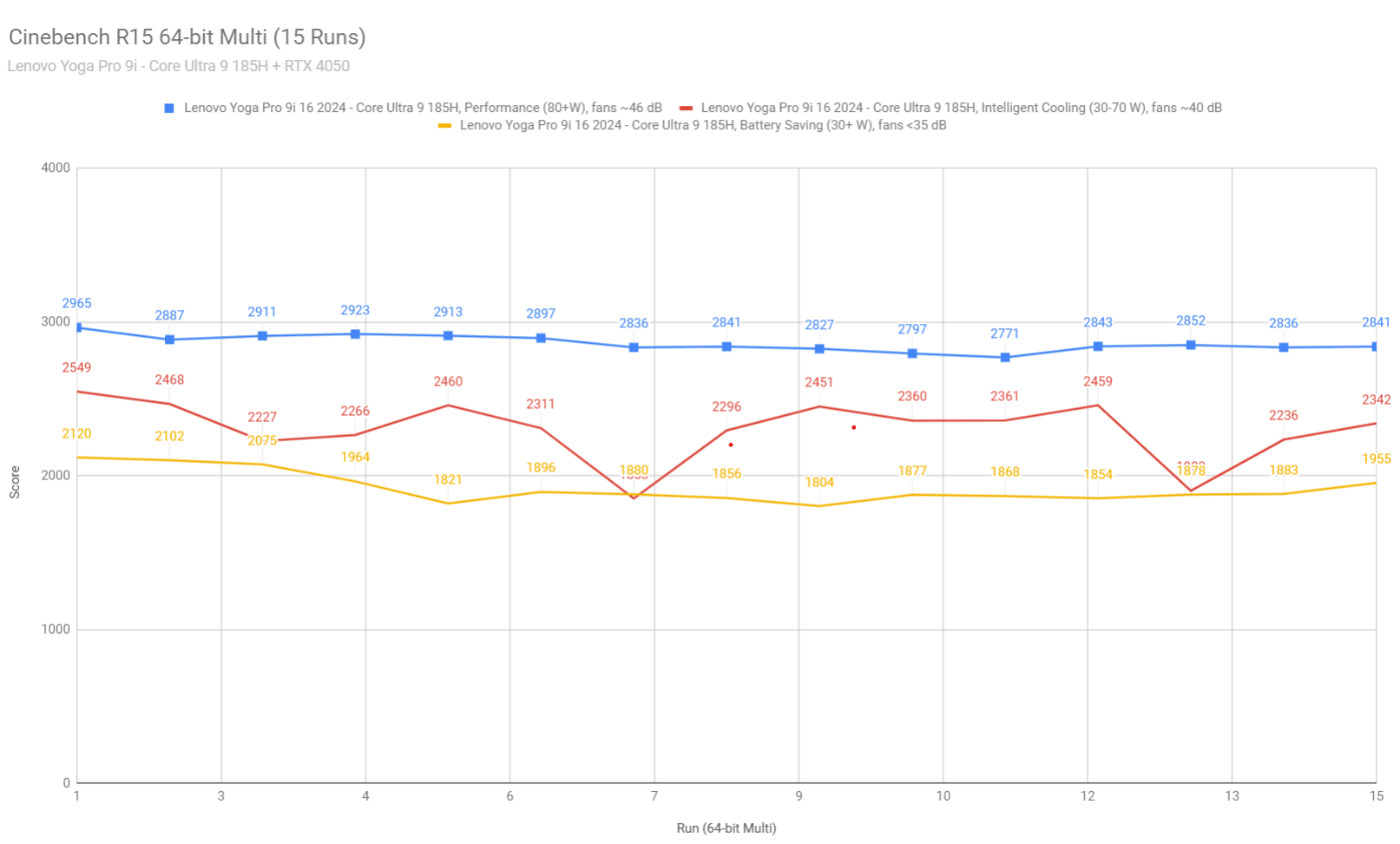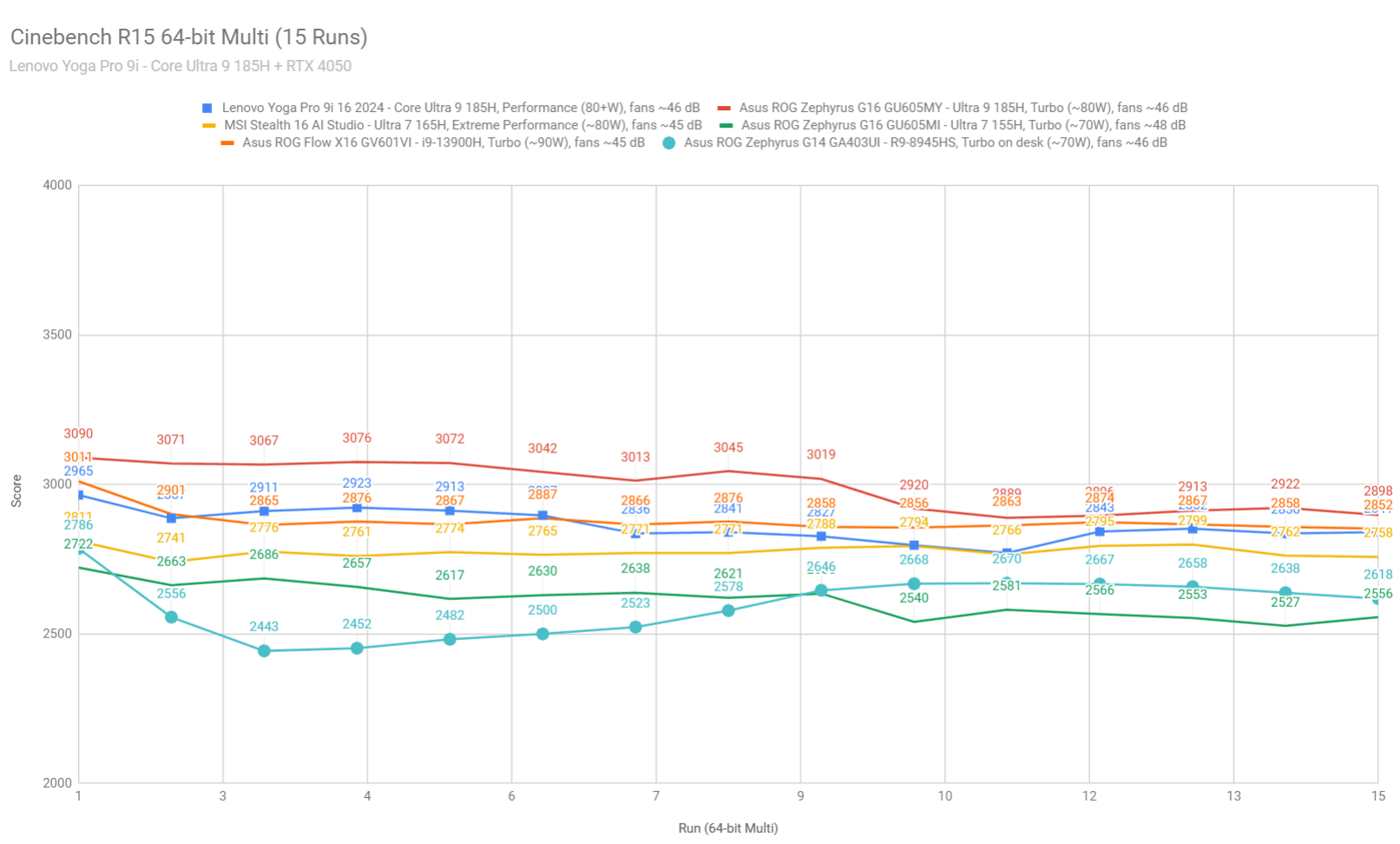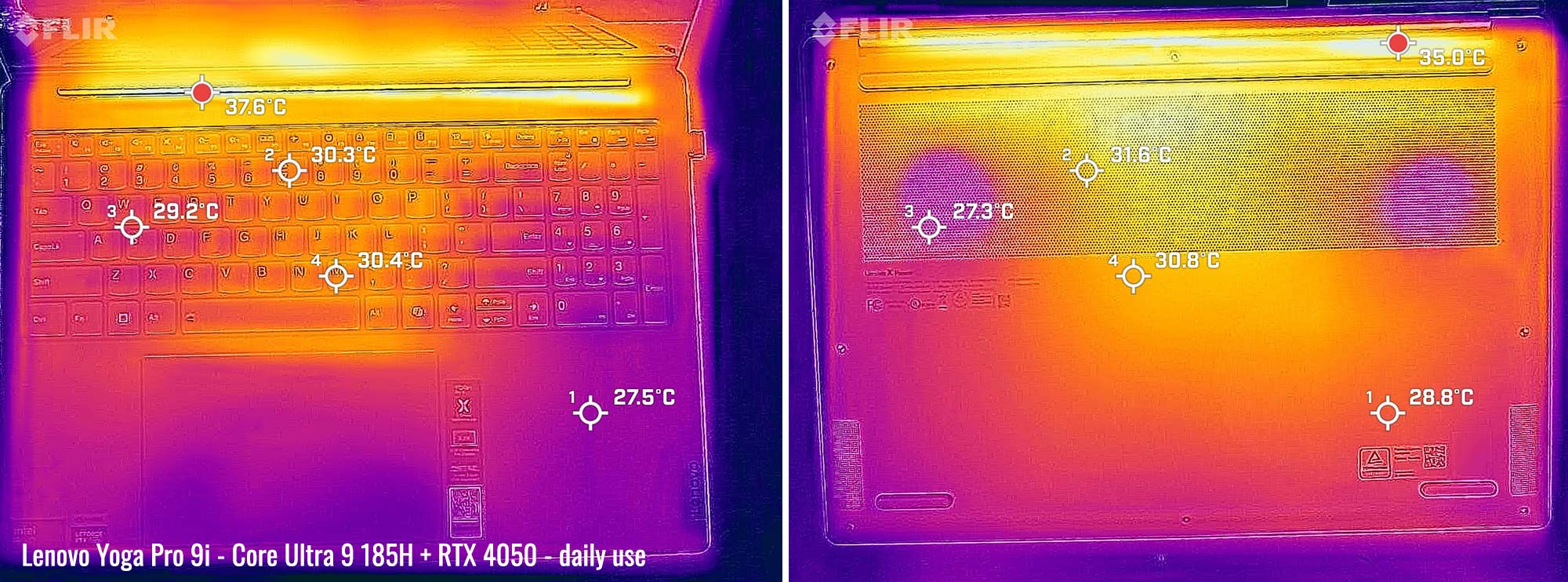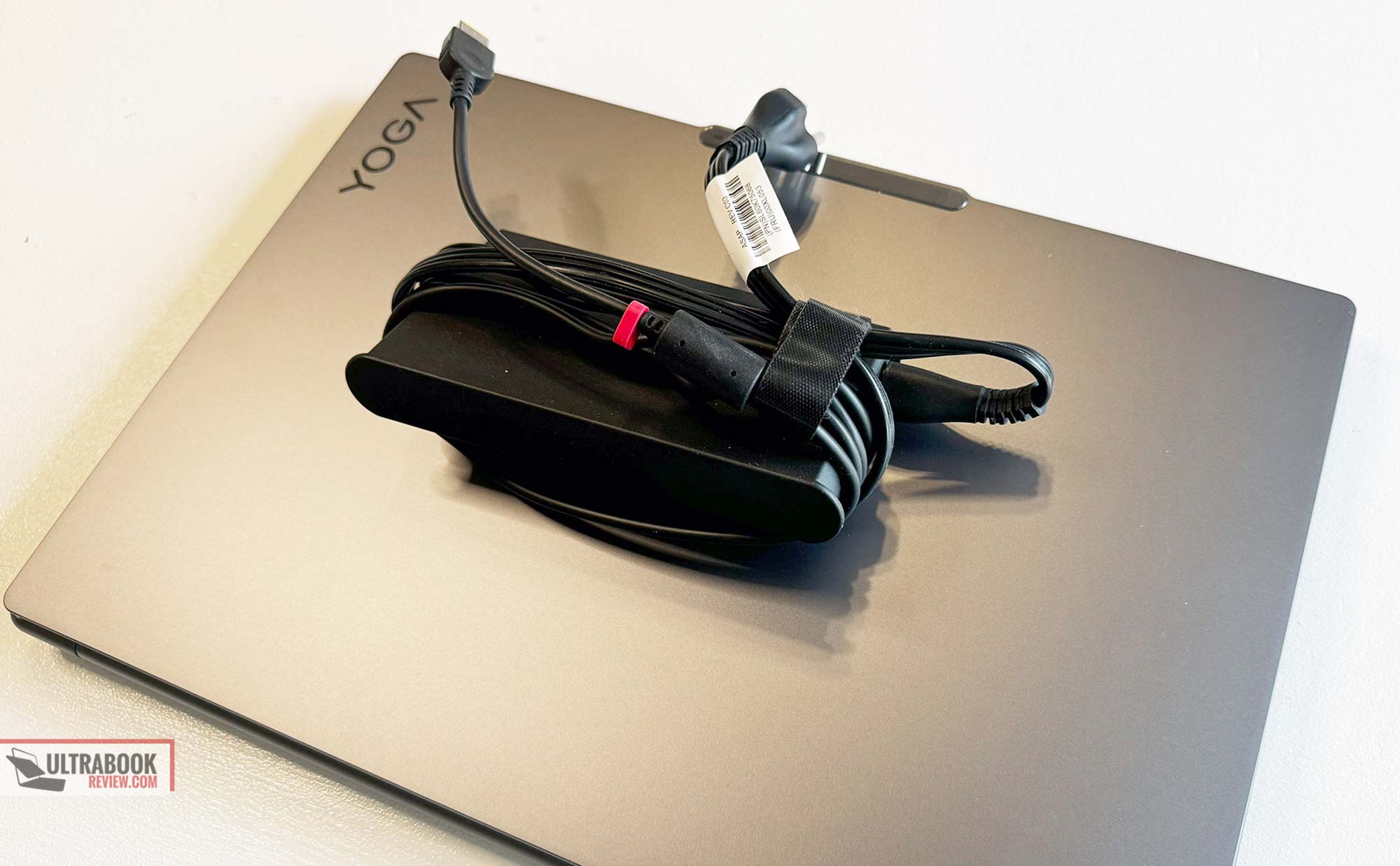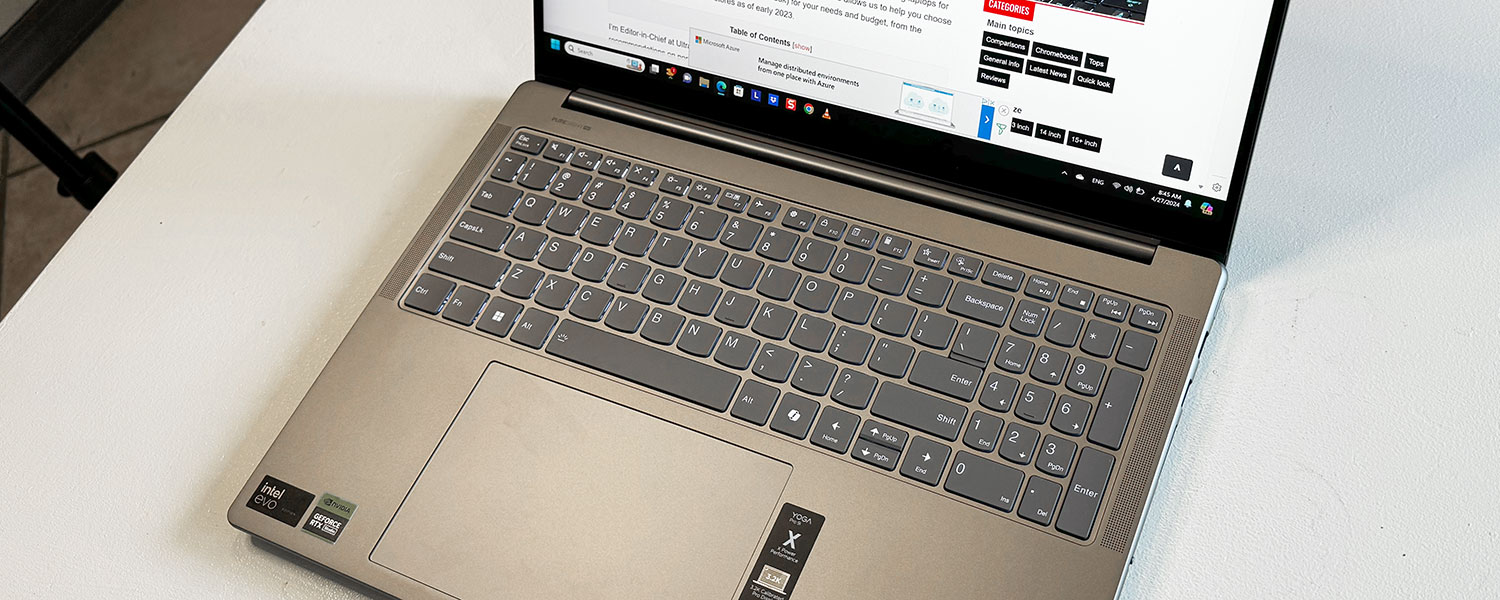This week, I’ve been focused on the Lenovo Yoga Pro 9i 16, Lenovo’s offering for a thin studio laptop.
It contains an Intel Ultra CPU with mid range Nvidia graphics and a large calibrated display and punchy speakers, making it a very nice choice for mixed daily use, as well as content creation and consumption.
The configuration I have comes with the Intel Ultra 9 185H CPU, which is the top Intel Meteor Lake CPU choice for this model, as well as Nvidia’s RTX 4050 GPU. It’s a good pairing for standard content creation and probably isthe most popular model, especially considering there’s an adequate amount of RAM in it and its competitive pricing.
I’ve spent the past 3 weeks testing this machine, and intentionally spent a solid week using it exclusively as my daily driver. I definitely like it, but there are a couple quirks that I think Lenovo needs to work on. It’s a very capable laptop though and certainly worth considering if you need a something of this sort.
Specs as reviewed – Lenovo Yoga Pro 9i 16 16IMH9 creator laptop
| Lenovo Yoga Pro 9i 16 (2024 16IMH9 model) | |
| Screen | 16 inch, 3200×2000 px, IPS, 165 Hz, HDR 400, 100% DCI-P3, touch |
| Processor | Intel Core Ultra 9 185H, 16 core, 6P + 8E+ 2LPE (5.1 GHz max) |
| Video | Intel Integrated graphics+ Nvidia GeForce RTX 4050 with 6GB of DDR6 VRAM |
| Memory | 32 GB DDR5 7467Mhz (soldered) |
| Storage | 1x 1TB M.2 NVMe gen 4 + 1 spare slot |
| Connectivity | Intel AX211 Wifi 6E with Bluetooth 5.2 |
| Ports | left: power plug, HDMI 2.1, 1x USB-C 3.2 (Thunderbolt 4, DP 1.2 and PD 3.0), 1x USB-C 3.2 (DP 1.2 and PD 3.0), audio jack right: 2x USB-A 3.2, SD card reader, camera eShutter |
| Battery | 84 Wh, 170W charger |
| Size | 362.7 mm or 14.28” (w) x 253.7 mm or 9.99” (d) x 17.9 mm or .70” (h), mini LED version from 18.3 mm thick |
| Weight | 2 kg (4.41 lbs) + charger, mini LED version from 2.05 kg |
| Extras | all metal build, clamshell format with 180 display, backlit keyboard (white) with NumPad, 5MP webcam with eshutter, 6x speakers (versions with dGPU) |
Lenovo offers this laptop in a handful of other variants as well, with Core Ultra 7 155H or Ultra 9 185H processors, 16/32/64 GB of RAM, RTX 4050, 4060 and 4070 graphics, and either IPS or mini LED panel options.
Design, build quality – refined Yoga chassis
The Lenovo Yoga Pro 9i is a slim and considerably light laptop for its size, with a clamshell design. It’s mostly a strong construction, but I did notice a small amount of creaking when handling it from the corners while open. Handling was generally really good and I appreciate the rounded edges on all the spots you’ll typically be touching.
The entire laptop is made from aluminum and the chassis is stamped. The same matte sandblasted finish is consistent throughout the design and the color is a dark grey. It’s perfect because it has a decent grip and yet doesn’t seem to show fingerprints like a darker black laptop would.
The top lid is smooth and flat with nothing remarkable about it other than a Lenovo logo in the bottom corner and a Yoga logo on the opposite end. The lip of the lid has a small protrusion that makes it easy to lift. Doing so is a one finger task and the lid comes right up.
The hinge is pretty strong though and is appropriate for a touchscreen implementation, without having too much wobble when poked. The lid is also pretty thick and doesn’t have much flex even in the corners. The webcam and IR array are housed in that lip and the screen has modest bezels, although I’ve certainly seen smaller.
The keyboard and trackpad will be covered later, but the keyboard is flanked by two upward facing speakers. There’s a Lenovo logo on the bottom corner and a small PureSight ad in the top left. There are also many stickers, although these can be peeled off. Only other thing to mention here is the exhaust vents which are between the hinge and the keyboard.
The bottom of the laptop has a couple short footpads towards the front and a larger and taller footpad towards the rear. The rear also has a very large intake grill to bring in fresh air from the bottom. This design makes sense and it should do well in our cooling tests. Also on the bottom are a couple of speaker grills for additional speakers.
There is a full array of IO on this laptop. Starting on the left, there’s a reversable power jack, which is the same as what is found on the Legion series of laptops. I tested it with my wife’s Legion Pro 5i charger and it works perfectly. Also on this side are a pair of USB-C ports which support DP 1.4 and Power Delivery 3.0. Only the front one supports Thunderbolt 4 though.
The headphone/microphone combo jack is towards the front of the USB-C ports. There’s also an HDMI jack right next to the power port. This HDMI supports 4k @ 60Hz. Lastly towards the front is another speaker grill, providing sound out the sides. There is an identical one on the right as well, totaling 6x speakers.
The right side has a power button towards the back, with an indicator light. Next to that, there are 2x USB-A slots which are USB 3.2 Gen 1. Further forward is a full sized SD card reader. Finally, we have a physical switch for the webcam, which I very much appreciate. Really, the only IO missing is an ethernet port, but it’s probably for the best since this laptop is too thin and it would look ugly.
Very impressive design though. Creaks aside, I really appreciate how well built it is and the variety of IO this model contains. It’s not a unibody design, so compared to the Asus G16 I have on hand, this feels slightly less sturdy made – hence the slight creakiness. But it is still largely acceptable and won’t disappoint the average user.
One thing that I found peculiar about this device is the lack of “yoga” though. I thought that having a 360-degree display was a must for the Yoga line, but this device does not fold all the way back like literally every other Yoga model I’ve reviewed before. You’re limited to 180 degrees on this one, which is still fine for this sort of laptop. But I just found it very misleading on my end, so I bet others might make the same mistake as well. So, there’s your warning. This model is not a 360-degree convertible.
Keyboard, touchpad on the Lenovo Yoga Pro 9i
The keyboard on this laptop is excellent. It has 1.5mm of key travel per key and the keys themselves are concave, making them very easy to strike. These are extremely similar to the keys on the 14” Yoga 9i I just reviewed, so typing this review was just as simple.
On this model, there is space for a full sized keyboard layout with a NumPad. I don’t necessarily care either way, but I usually lean towards not having a Numpad since it usually makes everything feel cramped. But this model does what the Legion series does and that’s making the numpad keys a little smaller to keep the spacing adequate.
The keyboard layout is pretty normal. There’s a lot of useful multimedia keys and nothing seems to be out of place. There’s a copilot key too, if you care for that sort of thing. I would have preferred for a fingerprint reader in place of it, to be honest. The up and down arrows are the only keys not properly sized.
The keyboard has two levels of white backlighting which can be controlled with Fn-Space. There’s also an auto setting which uses the ambient light sensor to turn it on in the dark. Or you can just turn it off. This is bare bones as far as backlighting goes, but at least the lighting looks nice and there’s an auto feature, unlike on the ThinkPad series.
The trackpad is a bit of a mixed bag for me, only because I found it a little buggy. I can’t really figure out what the cause is, but sometimes the situation will be I try to use it on a desk and my pointer sometimes will click randomly all over the place. And then I pull it on my lap and it’ll be perfectly fine.
Other times it’ll just randomly happen for 5-10 seconds out of nowhere, even while unplugged on my lap. And then I’ll get 4 hours straight of good behavior. It’s weird! I’ve tried turning down the sensitivity in Windows settings, which helps a little, but clearly something is wrong with my unit here.
That aside, when this issue doesn’t persist, the trackpad works fine. It’s large and all glass, so multitouch gestures and tracking work very well and my fingers glide smooth. It’s a little too large for me, so I struggled with palm rejection in the upper left corner at first. But after a day or two, I got used to it.
The trackpad is a clickpad style with buttons on the corners of the pad. I hardly used the clicks since it’s such a long way down to reach it, so I just opted for single and double taps which serve the same purpose.
My model also has a touchscreen, which is probably not what many people need for a 16” laptop, but it’s certainly nice to have. The screen is oleophobic, so feels very smooth, like a phone or tablet would. I didn’t use it a whole lot, but it worked well in the cases I did try it out. For me, this touchscreen would make more sense if the screen folded all the way back.
16-inch touch display, with IPS or mini LED panels
This model has a 16” 16:10 IPS variety screen, with a resolution of 3200×2000 px. It’s rated at 100% DCI-P3 and 400 nits of brightness, which I’ll measure more precisely in a second. The refresh rate is 165Hz and the screen itself is a glossy finish because of the glass touchscreen.
As a whole it’s a good screen. Many similar laptops this year are OLED, which has its advantages due to the unlimited contrast ratio and vivid colors. But this screen is no slouch and is pretty good for an IPS screen. My model has perfect viewing angles and absolutely no backlight bleed, so other than the blacks not being totally black like on OLEDs, there’s little to complain about here.
To give you some specifics, here’s what I measured using my Xrite tool:
- Panel HardwareID: Lenovo LEN8BA1 ; LEN160-3.2K
- Coverage: 137.6% sRGB, 97.5% DCI-P3, 94.8% AdobeRGB;
- Measured gamma: 2.2;
- Max brightness in the middle of the screen: 385 cd/m2
- Contrast at max brightness: 1118:1
- Native white point: around 6210 K;
- Black on max brightness: 0.34 cd/m2
Good readings that technically fall a little shy of reported values, but certainly within tolerances. The screen is probably good enough for most but if you want more from your screen, there is also a mini LED option which has zone-dimming and HDR1000 specs with a maximum brightness of 1200 nits. But both panels are glossy and support touch, so that’s good at least if you need that sort of thing.
Hardware and performance – Intel Meteor Lake, mid-tier Nvidia RTX graphics
My model comes with an Intel Ultra Core 9 185H Meteor Lake processor which has 16 cores, six of them being Performance cores, eight for Efficiency and two for Low Powered Efficiency. The max Turbo frequency boosts up to 5.1 Ghz.
Paired with the CPU is 32GB of fast DDR5 RAM and an Nvidia Geforce RTX 4050 GPU with 6GB GDDR6 VRAM. There’s a model with a 4060 GPU if you need more power as well. Lastly, my model has 1TB of fast SSD storage, supporting PCIe 4.0.
Simply put, this laptop performs excellently. I did a lot of higher end activities on this laptop while using it as my daily driver and it handled everything just as well as my typical daily laptop. I could easily see myself using this on a regular basis.
There are little upgrade options other than the SSD. There is a spare slot though, so if you need the extra storage, it’s pretty easy to do without imaging a new drive. Everything else is soldered though.
Lenovo Vantage is used to switch between the various power profiles. Fn-Q also switches between these in case you don’t want to use the software. Here are the observed power limits at each of the power profiles:
| Battery saver | Intelligent cooling | Performance | Perf on Battery | ||||
| TDP | TGP | TDP | TGP | TDP | TGP | TDP | TGP |
| 40/30W | 25W | 78/30W | 60W | 115/45W | 85W | 44/44W | 45W |
Also notable is the reasonable performance while on battery with the power profile in Performance mode. You can do quite a lot with 40+ watts on both the CPU and GPU. But it’ll cost you dearly on that battery life, so expect only about an hour if you’re pushing this laptop to its limits unplugged.
Let’s dig into the testing now.
Fist, the Cinebench R15 loop test for sustained CPU performance, on the available power profiles.
Solid results, with plenty of sustained CPU power in all cases. The CPU temperatures are very high on Performance mode, and the overall behavior on Intelligent Cooling is rather erratic, with the CPU fluctuating between power levels.
The performance on Battery Saver is quite interesting, though, at about 60% of Performance mode, but consistent and with good temperatures and quiet fans.
And here’s how the Core Ultra 9 185H in this Yoga Pro 9i fares in this sustained CPU test against other similar recent models and platforms. Competitive, but not a ground-breaking platform compares to Intel Core H and Ryzen HS implementations of the last two years.
Next, some of the synthetic benchmarks I’ve taken. For all testing, I forced the GPU into discrete mode and the first test was taken in Performance mode.
Here were my results in this mode:
- 3DMark 13 –CPU profile: max – 8978 16 – 8141, 8 – 6261, 4 – 3727, 2 – 1996, 1 -1003;
- 3DMark 13 – Fire Strike: 20748 (Graphics – 22524, Physics – 30512);
- 3DMark 13 – Time Spy: 9098 (Graphics – 8771, CPU – 11545);
- 3DMark 13 – Port Royal (RTX) Graphics: 4889;
- 3DMark 13 – Speed Way: 1936;
- Uniengine Superposition – 1080p Extreme: 4712;
- Uniengine Superposition – 1080p Medium: 14934;
- GeekBench 6: Single-Core: 2550, Multi-core: 14000;
- CineBench R15: CPU 3005 cb, CPU Single Core 284 cb;
- CineBench R23: CPU 19213 pts, CPU Single Core 1879 pts;
- CineBench 2024: GPU 8249 pts, CPU 1094 pts, CPU 10 minute run 1081 pts, CPU Single Core 110 pts;
- SPECviewperf 2020 – 3DSMax: 78.56;
- SPECviewperf 2020 – Catia: 50.93;
- SPECviewperf 2020 – Creo: 86.64;
- SPECviewperf 2020 – Maya: 313.08;
- SPECviewperf 2020 – Medical: 29.56;
- SPECviewperf 2020 – SNX: 21.64;
- SPECviewperf 2020 – SW: 188.62.
Solid CPU performance for this class. The GPU, well, it’s a 4050, so not that much today.
Next I set the mode to Intelligent Cooling in Vantage:
- 3DMark 13 –CPU profile: max – 7719 16 – 7555, 8 – 5821, 4 – 3791, 2 – 2070, 1 -1049;
- 3DMark 13 – Fire Strike: 18684 (Graphics – 20724, Physics – 29555);
- 3DMark 13 – Time Spy: 8196 (Graphics – 7841, CPU – 11035);
- 3DMark 13 – Port Royal (RTX) Graphics: 4552;
- 3DMark 13 – Speed Way: 1677;
- Uniengine Superposition – 1080p Extreme: 4774;
- Uniengine Superposition – 1080p Medium: 14027;
- GeekBench 6: Single-Core: 2453, Multi-core: 11882;
- CineBench R15: CPU 2579 cb, CPU Single Core 280 cb;
- CineBench R23: CPU 17782 pts, CPU Single Core 1902 pts;
- CineBench 2024: GPU 8336 pts, CPU 1037 pts, CPU 10 minute run 1032 pts, CPU Single Core 113 pts;
Finally, here are my results after switching to Battery Saver mode. This should have been called Quiet mode considering it can be switched to this while plugged in:
- 3DMark 13 –CPU profile: max – 6340 16 – 6076, 8 – 4953, 4 – 3527, 2 – 1785, 1 -830;
- 3DMark 13 – Fire Strike: 5293 (Graphics – 5486, Physics – 23854);
- 3DMark 13 – Time Spy: 2354 (Graphics – 2077, CPU – 9733);
- 3DMark 13 – Port Royal (RTX) Graphics: 1188;
- 3DMark 13 – Speed Way: 524;
- Uniengine Superposition – 1080p Extreme: 1110;
- Uniengine Superposition – 1080p Medium: 3567;
- GeekBench 6: Single-Core: 1955, Multi-core: 8702;
- CineBench R15: CPU 2147 cb, CPU Single Core 226 cb;
- CineBench R23: CPU 13540 pts, CPU Single Core 1617 pts;
- CineBench 2024: GPU 2556 pts, CPU 684 pts, CPU 10 minute run 682 pts, CPU Single Core 91 pts;
These are very decent results and that power limit on the GPU makes for some very capable use cases for this laptop, even games. Performance and Intelligent Cooling modes worked very well and similarly for most tasks I used the laptop for. For the most part, Intelligent Cooling mode makes the most sense on this device, since it’s easier on the fans.
On most laptops, I would recommend “quiet” or battery saver mode for some uses. But for this one, I would only recommend it for anything that doesn’t require the GPU, as performance drops by as much as 75% if you need it.
I also did some more testing with games. This machine comes with the Geforce RTX Studio drivers, which my testing above utilized. But I was able to install the gaming drivers and I took these readings in different Performance options in Vantage:
| 3K – Performance | 3K – Intelligent cooling | 3K – Battery Saver | |
| Hogwarts Legacy, Ultra Preset | 32 fps avg, 14 fps 1% low | 29 fps avg, 24 fps 1% low | 8 fps avg, 7 fps 1% low |
| The Witcher 3: Wild Hunt (Ultra Preset, AA: TAAU, Hairworks Off) | 57 fps avg, 47 fps 1% low | 53 fps avg, 38 fps 1% low | 16 fps avg, 3 fps 1% low |
| The Witcher 3: Wild Hunt (DX 12, Ultra Preset, AA: TAAU, Hairworks Off, RT: Quality, DLSS Frame Gen Off) | 30 fps avg, 19 fps 1% low | 24 fps avg, 21 fps 1% low | – |
| Horizon Forbidden West (High, DLSS Performance) | 39 fps avg, 35 fps 1% low | 38 fps avg, 35 fps 1% low | 15 fps avg, 7 fps 1% low |
| Satisfactory (Ultra) | 102 fps avg, 62 fps 1% low | 87 fps avg, 41 fps 1% low | 34 fps avg, 14 fps 1% low |
| Valheim (High preset) | 44 fps avg, 28 fps 1% low | 42 fps avg, 26 fps 1% low | 10 fps avg, 7 fps 1% low |
| Final Fantasy 7 remake (Max settings, QHD) | 70 fps avg, 8 fps 1% low | 67 fps avg, 10 fps 1% low | 27 fps avg, 15 fps 1% low |
This is surprisingly decent especially considering that I didn’t turn down the resolution at all. And boy does that screen really make games look good at 3k. As long as you’re not playing the latest AAA titles on Ultra, you can expect to get at least 40fps on many games in Performance mode. Intelligent Cooling is close, with somewhat quieter fans, and Battery Saver is just not meant for demanding loads.
And if you turn that resolution or graphics settings down, you can certainly get those framerates even with more demanding titles. Check it out.
| FHD+ , in Performance mde | |
| Hogwarts Legacy, Ultra Preset | 84 fps avg, 19 fps 1% low |
| The Witcher 3: Wild Hunt (Ultra Preset, AA: TAAU, Hairworks Off) | 112 fps avg, 70 fps 1% low |
| Horizon Forbidden West(High, DLSS Performance) | 47 fps avg, 42 fps 1% low |
| Satisfactory(Ultra) | 137 fps avg, 70 fps 1% low |
For a middle of the road GPU, I think it’ll satisfy most users out there that need a workstation or want a leisure laptop that’s not overly heavy. There’s tough competition out there but this one has some features to make it stick out and the performance certainly helps.
Emissions (Noise, Heat), connectivity, speakers, camera
The Lenovo Slim Pro 9i has a dual fan cooling solution with three heatpipes and only two heatsinks.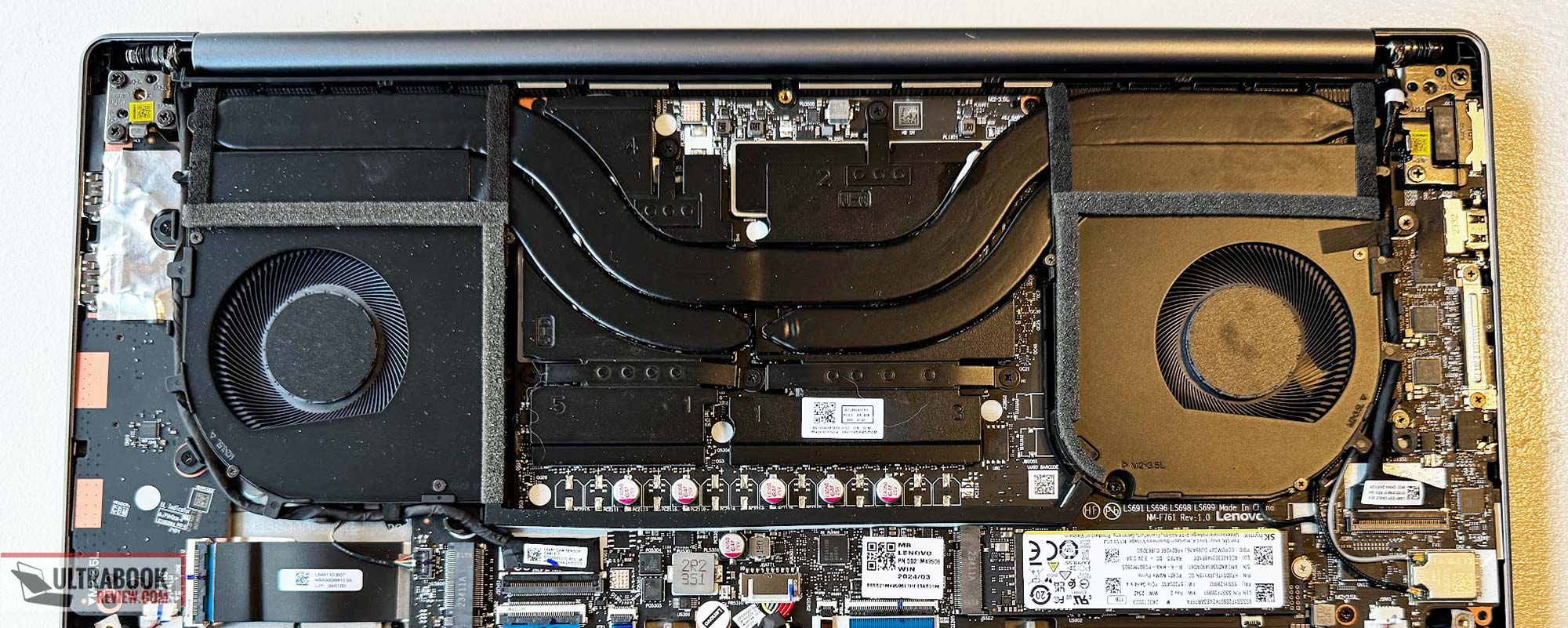

This is mostly an adequate design for this hardware and works out pretty well for the most part.
I ran a test using Horizon Forbidden West on High settings. This game pushes the hardware and allows me to test the cooling system as well as measure the fan noise. Here were my results:
| Mode | Performance | Intelligent Cooling | Battery Saver |
| CPU temps | 84 C avg with 102 C spike | 62 C avg with 82 C spike | 65 C avg with 79 C spike |
| GPU temps | 68 C avg | 65 C avg | 57 C avg |
| Avg fan noise after stabilized temps | 46 dB | 40dB | 32dB |
| Game performance | 39 fps avg, 35 fps 1% low | 38 fps avg, 35 fps 1% low | 15 fps avg, 7 fps 1% low |
And here are some logs for Horizon Forbidden West.
And some logs in Satisfactory, with similar results.
These results are about what I expect, but that battery mode sure has some low fan noises. Unfortunately the Performance mode is fairly loud, so pretty bad in that mode. I think if I were to use this regularly, I would probably just stick with the Intelligent Cooling mode, as 40dB isn’t quite so bothersome and it still offers plenty of performance.
Chassis temps were very reasonable. My streaming video test showed no spots that worried me and all the heat seems to be going out the hinge where it belongs.
My gaming test, on the other hand, shows a minor hot spot on the bottom center. It’s well within tolerance though and probably wouldn’t make contact with your leg since it’s in the middle. I think it’s probably safe to use this without a laptop tray when using it under load – just be sure not to fully block the intake vents.
For what its worth, I’m satisfied with the cooling system as a whole. It’s very quiet under typical use and isn’t even all that loud under normal working loads. More importantly it doesn’t seem to get too hot, both inside and out. Sure, those spikes on performance mode are high, but that’s actually typical of all laptops really. And the amount of performance on the IC profile should probably sway most in that direction anyways.
As far as connectivity goes, the Wifi reception was great. This machine contains an Intel AX211, which I’ve seen in most of the other units I’ve reviewed – it’s very popular. And rightfully so, as it’s about the best you can get until Wifi 7 takes off. Taking my typical speed test from 20+ft from my router resulted in 695 Mbps. Really good result!
The Wifi card also has Bluetooth 5.2, which worked fine during my usage. I used my Airpods constantly and didn’t experience any drops in connection.
The speakers on this laptop are excellent. We have two upward facing tweeters and two more downward facing speakers which cover more of the mids and bass. The max amplitude is 75dB(A), but he sound is rich in range and feels like it easily fill a room when turned all the way up.
My bass test turned out very good too, as I was able to detect bass as low as 75Hz. I could easily see myself using a laptop like this without headphones, whether it be conference calls, streaming media and even some games. They are much better than most competitors.
The webcam on this model is a 5MP(QHD) shooter. The image looks great when there’s ample lighting, but the image starts to get noisy in dimly lit areas and the colors start to fade.
This camera also has Windows Hello enabled and it works perfectly. I’m able to face unlock in a well lit or completely dark room with ease. There’s no fingerprint reader on this model, so face unlock is the only biometrics you get on this one.
Another feature with the camera is presence detection, which is on by default in the Lenovo Vantage software. This means when you leave your computer and it goes to sleep with the lid open, it’ll keep the camera active to detect when you return. Then it will automatically wake the computer and unlock with your face. A little eerie but it works well.
There is an eshutter switch on the right side of the chassis if you want to disable your camera all together though. This will by default disable face unlock and the presence detection, but keep in mind these features can also be disabled individually in the Vantage software. The switch is super convenient to do in a pinch too.
Battery life – decent runtimes with casual use
This Lenovo Yoga Pro 9i has a pretty large 84Whr battery, taking advantage of the limited space inside. I took my usual series of battery life tests with the brightness set to 50%, which is about 88 nits. Here’s what I got:
- 7.8 W (~10 h 46 min of use)– idle, Quiet mode with battery saver on, screen at 0%, Wi-Fi ON, backlighting off;
- 17.9 W (~4 h 42 min of use)– text editing in Word/Excel with light internet use, screen at 30%, Wi-Fi ON;
- 13 W (~6 h 28 min of use)– 1440p 60hz Youtube fullscreen in Chrome, screen at 30%, Wi-Fi ON;
- 10.9 W (~7 h 42 min of use)– 1080p streaming fullscreen video in Chrome, screen at 30%, Wi-Fi ON;
- 33.9 W (~2 h 29 min of use)– heavy browsing in Chrome, screen at 30%, Wi-Fi ON;
- 107.6 W (~0 h 47 min of use)– Gaming – Witcher 3 60fps, screen at 50%, Wi-Fi ON.
These are pretty good results unless you plan on using your laptop for heavy internet use on a regular basis. You have to do some tweaking to get the most out of it though, because if you accidentally leave it in Performance mode, the CPU regularly spikes and the power drain is noticeable. Switching to Battery Saver mode via Fn-Q is all you need to do.
The power brick on this model is modest, at 170W. It’s reasonably portable and is pretty similar to what you’d fine on most Lenovo laptops with a 4050, including the Legion series. It connects via a reversable slip connection, also similar to Legion laptops.
Price and availability- Lenovo Yoga Pro 9i 16
The model I have on hand is currently available at Best Buy for $1499, with a $200 discount off the MSRP price. That’s a fair price, but what’s interesting is that the higher end model containing an RTX 4060 and the mLED screen is only $150 more. If it were me, I’d take my chances on the top model first. That price is well worth the upgrade if you ask me.
It’s not available at Amazon yet, but here’s a link that you should check for updates at the time you’re readind this article.
Final thoughts- Lenovo Yoga Pro 9i 16-inch review
To sum it up, I think the Lenovo Yoga Pro 9i 16 is a pretty good choice if you’re looking for a 16” laptop that has a little more features for creators. It’s thin and light for what it is, especially considering you have a capable performing CPU and GPU inside, which need a good heatsink to function well.
Throughout my use, I was constantly comparing it to my Asus ROG Flow X16 and Asus ROG Zephyrus G16 which I had on hand. There’s much to like about each model, but where this one stands out over the x16 is probably the IO placement. Otherwise, it’s very similar in versatility, visuals, speakers and even in performance (especially with the 4060 model), although the ROG laptops have a slightly edge there as they’re higher power designs. The X16 was quite expensive too when you pump up the specs, so this Yoga Pro 9i might be a better buy if you can live without the screen folding all the way back.
But compared to the Asus Zephyrus G16, this Yoga really only has an advantage of the screen folding much further back and touch capability. Otherwise the G16 has a slightly lower price (except with less RAM), an arguably better OLED screen and better construction quality.
But if Lenovo is your brand and you’re looking for something that has a reasonable amount of versatility and capable performance, this might be a really good option for you. Especially if you use that 10-key Numpad because those options are becoming more and more scarce these days.
The biggest things I liked about this model are the handling, the IO availability and the convenience of use. Being able to open my laptop and have it turn on, unlock and get to work is a very big deal to me. Especially since I’m constantly just closing my lid and letting it rest in sleep mode a lot. Sure, most laptops are like this, but this model felt very snappy in this sense and the input devices were super easy to adapt to and use on a regular basis. I could totally use this laptop for serious work and be fine.
But the trackpad issues totally spoil the experience for me and I really hope this is just an issue with my unit and not something widespread. I did take a look at recent reviews and there have been none exactly like mine but there were a couple of people complaining about palm rejection, so perhaps that is related and could be fixable by software. Assuming it’s just me, everyone else should be fine – but I would call this a dealbreaker if it’s a more common issue. So, make sure you check carefully for this when buying.
The build quality with minor creaking might also be an issue for some folks, so keep that in mind too. I honestly don’t think it’s all that bad, but those who are used to unibody construction would certainly notice and probably criticize it. For a stamped design, I think this is to be expected though.
Other than that, there wasn’t anything else I found alarming about this model. I would have liked for it to maybe fold all the way back like a Yoga model should, but if not for the name, I find it fine as it is. I also would probably lean towards the mLED model and would consider everything else to be pretty much perfect.
Really, with this machine, you’re getting a good CPU paired with a reasonably powered mainstream GPU with a lot of RAM. This is all you need for some serious work if you’re a content creator and it also performs well for some casual gaming, if that’s your thing. The sound also is good, so using it for media consumption is ideal as well too.
So there’s the good and the bad. Hopefully this review paints a better picture on what to expect. Please leave me a comment below on what you think.

